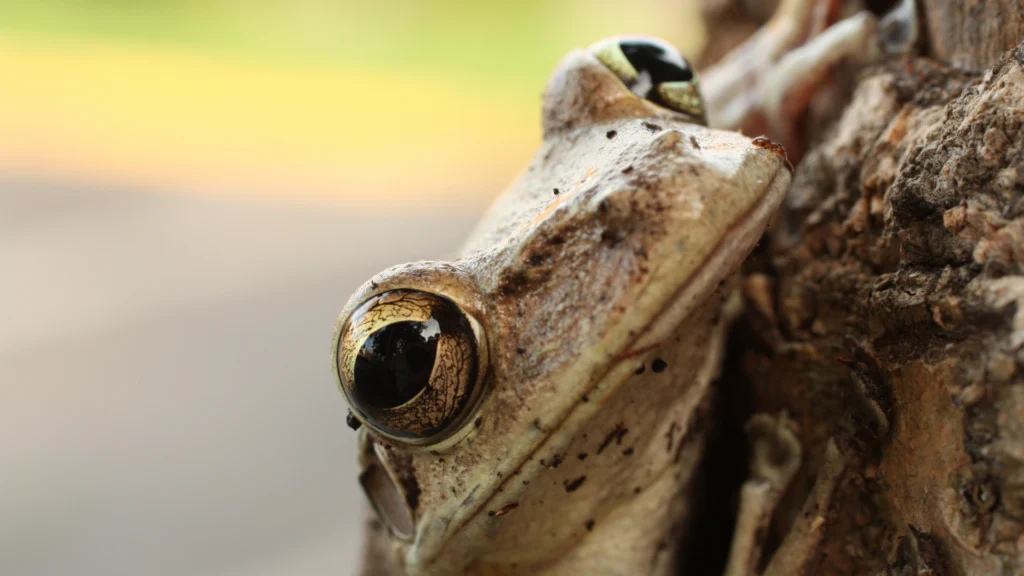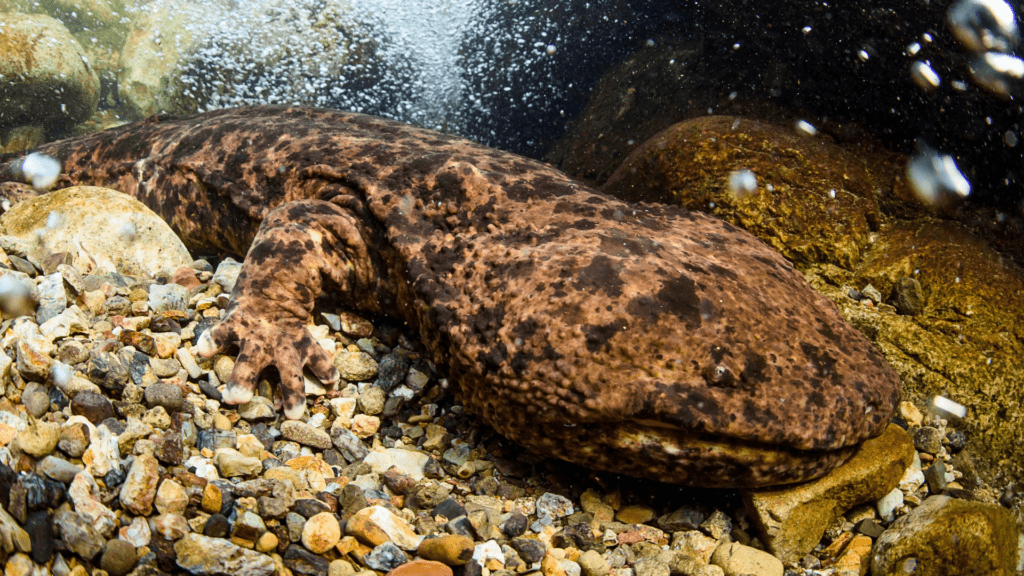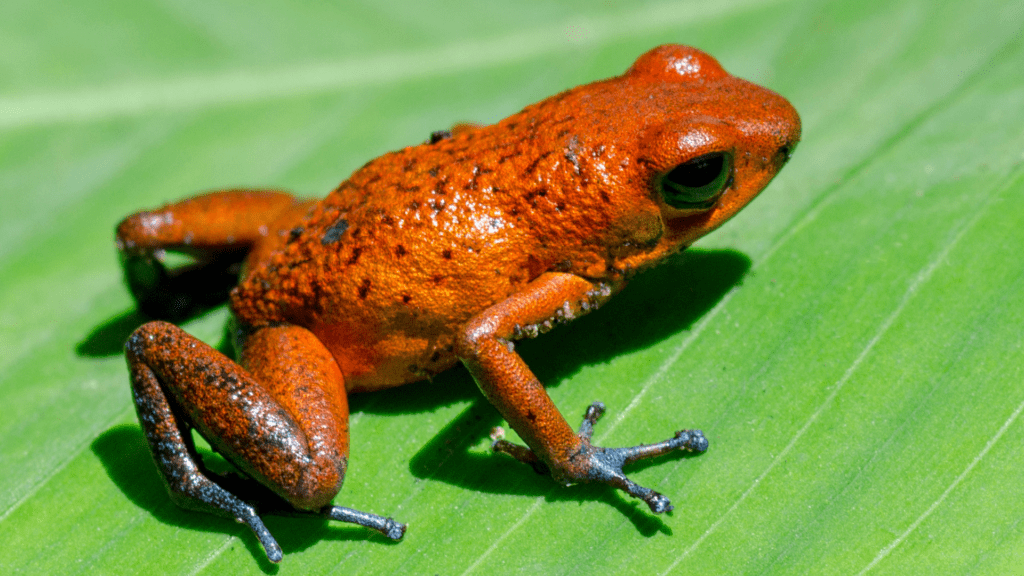Cuban Tree Frog (Osteopilus septentrionalis) is the largest tree frog species in North America. Known for its adaptability and voracious appetite, this invasive amphibian poses a significant threat to native wildlife. Their presence disrupts ecosystems, making them a concern for conservationists. Despite their ecological impact, these frogs are commonly found in the pet trade.
Scientific Classification
Kingdom: Animalia
Phylum: Chordata
Class: Amphibia
Order: Anura
Family: Hylidae
Genus: Osteopilus
Scientific Name: Osteopilus septentrionalis
Physical Description
- Size: Ranges from 3 to 5.5 inches (76-140 mm), with females being larger than males.
- Color: Varies from olive-brown and bronze to grayish-white and grey, often with dark splotches on the back and orange hues on the hidden surfaces of their legs.
- Body: Stocky and rounded, with tadpoles having broad caudal fins.
- Head: Features orange-tinted eyes and fused skin to the skull, reducing water loss.
- Mouth Structure: Tadpoles have six rows of labial teeth (two on the upper jaw and four on the lower jaw).

Distribution
Cuban Tree Frog Native to Cuba, the Cayman Islands, and the Bahamas, these frogs have expanded to regions like the U.S. Virgin Islands, Puerto Rico, the British Virgin Islands, Hawaii, the Lesser Antilles, and southern Florida and South Carolina. Debate exists about whether they are native to Key West, Florida.
Habitat & Adaptability
Cuban Tree Frog is highly adaptable and thrives in a variety of environments, showcasing its incredible resilience. Here’s a closer look at its habitat preferences and unique adaptations, while avoiding repetitive use of its name:
Preferred Habitat
Cuban Tree Frog is commonly found in humid environments where temperatures range between 23°C and 29°C (73°F-84°F). These conditions provide the ideal climate for its survival and reproduction.
Tree-Dwelling Lifestyle
Cuban Tree Frog While prefers large and medium-sized trees, this species is also known to inhabit artificial structures such as buildings, fences, and even garden decorations. This adaptability allows it to thrive in both natural and urban settings.
Brackish Water Tolerance
One of the most fascinating adaptations of this amphibian is its ability to survive in brackish water—a mix of fresh and saltwater. This unique trait has enabled it to spread across islands and coastal regions, where other amphibians might struggle to survive.
Versatility in Habitat Selection
Cuban Tree Frog is highly versatile and can be found in a range of habitats, including:
- Forests: Dense tree cover provides ample hiding spots and hunting grounds.
- Wetlands: Proximity to water sources is essential for breeding and hydration.
- Urban Areas: Artificial structures and gardens offer alternative habitats.
Adaptations for Survival
Several adaptations help Cuban Tree Frog thrive in diverse environments:
- Camouflage: Its coloration blends seamlessly with tree bark and foliage, offering protection from predators.
- Climbing Ability: Strong, adhesive toe pads allow it to climb trees and artificial structures with ease.
- Temperature Tolerance: It can endure a range of temperatures, from warm, humid climates to cooler conditions.
Role in the Ecosystem
Cuban Tree Frogs plays a vital role in its ecosystem by:
- Controlling insect populations: It feeds on a variety of insects, helping to maintain ecological balance.
- Serving as prey: It provides food for larger animals like birds and snakes, supporting the food chain.
Conservation and Habitat Protection
Protecting the habitats of this amphibian is crucial for its survival. Conservation efforts focus on:
- Preserving forests and wetlands: Ensuring these natural habitats remain intact.
- Reducing pollution: Keeping water sources clean and free from contaminants.
- Creating wildlife-friendly urban spaces: Encouraging the coexistence of humans and wildlife.
This adaptable and resilient species is a testament to the wonders of nature. generations.
Diet: Voracious and Opportunistic
Cuban Tree Frog is known for its voracious appetite and ability to consume a wide variety of prey, making it a highly effective predator. Here’s an expanded look at its diverse diet and feeding habits, while avoiding repetitive use of its name:
Insectivorous Diet
A significant part of this amphibian’s diet consists of insects, which provide essential nutrients for its survival. Some of its favorite insect prey includes:
- Crickets: A common and easily accessible food source.
- Cockroaches: Often found in urban and natural environments.
- Spiders: Both web-building and ground-dwelling species are targeted.
Predation on Vertebrates
In addition to insects, this species is capable of preying on small vertebrates, showcasing its adaptability and opportunistic feeding behavior. Its vertebrate prey includes:
- Small Frogs: It often consumes smaller amphibians, including juveniles of other species.
- Lizards: Small reptiles are a common target, especially in shared habitats.
- Mice: Occasionally, it captures and consumes small rodents.
- Hatchling Birds: Nestlings and eggs are vulnerable to its predation.
- Small Snakes: Even young snakes are not safe from its appetite.
Hunting Strategies
This amphibian employs several strategies to capture its prey:
- Ambush Hunting: It often waits motionless for prey to come within striking distance.
- Active Foraging: It actively searches for food, especially in areas with abundant prey.
- Nocturnal Feeding: Being primarily nocturnal, it hunts under the cover of darkness, using its keen eyesight and agility to locate and capture prey.
Role in the Ecosystem
As a generalist predator, this species plays a crucial role in controlling populations of both insects and small vertebrates. By keeping these populations in check, it helps maintain the balance of its ecosystem.
Impact on Native Species
While its diverse diet is a testament to its adaptability, it can also pose a threat to native species, especially in regions where it has been introduced. Its predation on smaller amphibians, reptiles, and birds can disrupt local ecosystems, making it an important focus for conservation efforts.
Feeding Adaptations
Several adaptations make Cuban Tree Frog an effective predator:
- Sticky Tongue: Its rapid and sticky tongue allows it to capture prey with precision.
- Strong Jaws: It can consume larger prey by using its powerful jaws.
- Camouflage: Its ability to blend into its surroundings helps it ambush prey successfully.
This species’ diverse diet and feeding habits highlight its adaptability and importance in its ecosystem. By understanding its role as a predator, we can better appreciate its ecological significance and work toward its conservation.
Behavior & Unique Traits
- Nocturnal hunters, resting in trees by day.
- Attracted to artificial lights, leading to power outages when they invade electrical infrastructure.
- Strong climbers that easily adapt to human environments.
Predators & Defense Mechanisms
- Natural predators include raccoons, skunks, and large snakes.
- Defense adaptations include:
- Bright orange leg coloration that startles predators.
- Toxin secretion that deters attacks.
- Camouflage ability that blends them with surroundings.
Reproduction & Lifecycle
- Cuban Tree Frog Breeding occurs year-round, peaking between May and October.
- Sexual maturity is reached at 5 to 7 years.
- Females Cuban Tree Frogs lay eggs in standing water (pools, ponds, buckets), averaging 3,900 eggs per clutch.
- Eggs hatch within 30 hours, and tadpoles metamorphose within 30 days.
Lifespan
Cuban Tree Frog live between 5 and 10 years in the wild.
Vocalization
- Cuban Tree Frog Produce loud rasping or snoring calls similar to Southern Leopard Frogs.
- Cuban Tree Frog Emit a high-pitched scream when threatened.
Cuban Tree Frogs as Pets: A Controversial Choice
Although readily available, Cuban Tree Frogs are not ideal pets due to their toxic skin secretions, which can cause eye irritation, skin reactions, and asthma.
Pet Care Requirements
- Tank Size: At least 20″ × 24″ × 10″ per frog.
- Temperature: Should not fall below 70°F or exceed 90°F.
- Water: Needs a small dish of dechlorinated or spring water, changed daily.
- Feeding: Diet includes crickets, worms, slugs, and cockroaches.
- Temperament: Cannibalistic; should not be housed with other frogs or lizards.
Interesting Facts
- Cuban Tree Frogs change color based on temperature and surroundings.
- Their skull is fused to the skin, preventing movement.
- Their eyeballs help push food down their throats.
- They often hitchhike on plants and shipments.
- Banned in Hawaii, with penalties including $25,000 fines and jail time for importation.
Conservation Status
- Classified as “Least Concern” by the IUCN, but their invasive nature threatens biodiversity.
- Known to decimate native frog and lizard populations in introduced regions.
Conclusion
The Cuban Tree Frog is both an ecological threat and a fascinating species. While their adaptability has ensured their survival, their impact on native species makes them a subject of concern. Conservation efforts focus on controlling their spread to preserve biodiversity. Though available as pets, their potential risks make them unsuitable for casual pet owners.
faq’s
1. Why are Cuban Tree Frogs considered an invasive species?
Cuban Tree Frogs rapidly adapt to new environments, outcompete native species for food and habitat, and have a high reproductive rate.
2. What impact do Cuban Tree Frogs have on local ecosystems?
Cuban Tree Frogs prey on native frogs, lizards, and small animals, causing declines in native biodiversity.
3. Can Cuban Tree Frogs survive in cold temperatures?
Cuban Tree Frogs prefer warm climates and cannot tolerate temperatures below 10°C (50°F) for extended periods.
4. Are Cuban Tree Frogs poisonous?
Yes, their skin secretes toxins that can cause eye irritation, skin reactions, and asthma in humans.
5. How can I identify a Cuban Tree Frog?
Cuban Tree Frogs are larger than most tree frogs, have rough skin, and often exhibit varying colors with bright orange on their legs.
6. What should I do if I find a Cuban Tree Frog in my yard?
Cuban Tree Frog is recommended to humanely remove them to prevent harm to native species. Local wildlife agencies may provide guidance.
7. How do Cuban Tree Frogs reproduce so rapidly?
Cuban Tree Frogs lay up to 3,900 eggs per clutch multiple times a year, and their tadpoles develop quickly, reaching adulthood within weeks.
8. Can Cuban Tree Frogs be kept as pets?
While legal in some places, they are not ideal pets due to their toxicity and potential ecological impact if released into the wild.
9. What is the lifespan of a Cuban Tree Frog?
In the wild, they live between 5 and 10 years, depending on environmental conditions.
10. How can their spread be controlled?
Public awareness, removal programs, and habitat management strategies are essential to controlling their population growth.

